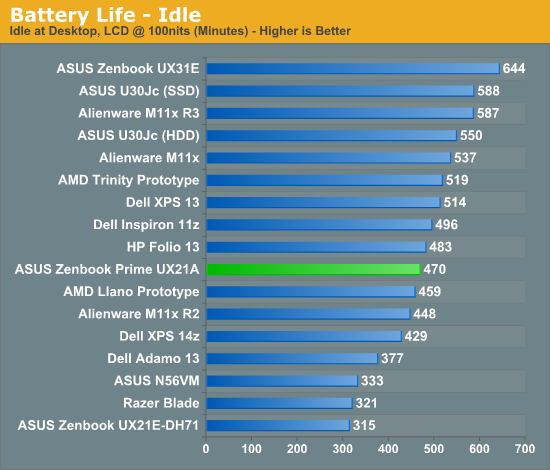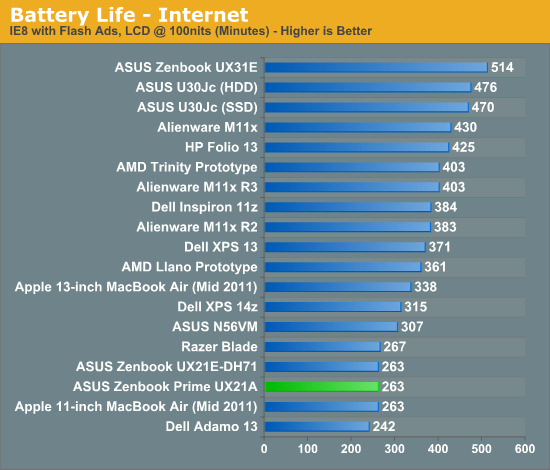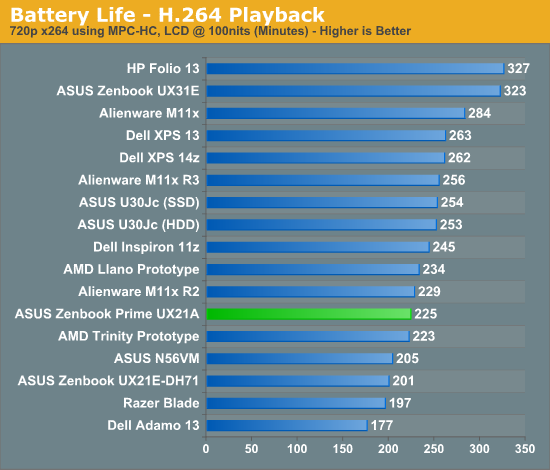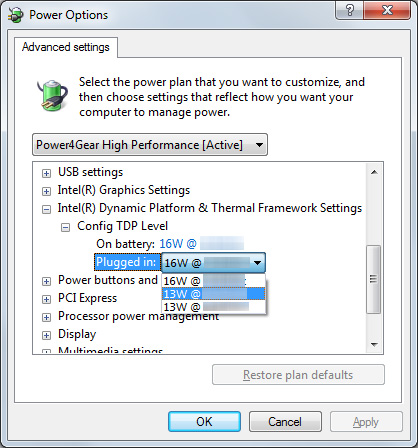ASUS Zenbook Prime (UX21A) Review: The First of the 2nd Gen Ultrabooks
by Anand Lal Shimpi on May 22, 2012 2:46 PM EST- Posted in
- Laptops
- CPUs
- Asus
- Ivy Bridge
- Zenbook
- Zenbook Prime
- Ultrabook
- Notebooks
Battery Life
Generally speaking, the 11-inch Zenbook Prime delivers about the same amount of battery life as its predecessor. For some reason we're able to hit much longer idle battery life on the Prime than the original Zenbook although I'm still trying to find out why. There's also an 11% improvement in our x264 playback test, but on average I'd expect to see similar battery life to the Sandy Bridge model - just with better performance. Note that these results also come despite the fact that ASUS is driving a much higher resolution, and presumably higher power, display than the original Zenbook.



The Zenbook Prime bucks the trend Jarred saw with the first Ivy Bridge notebook review where battery life took a small step backwards. These results bode well for future Ivy Bridge notebooks and Ultrabooks. It still remains to be seen if Intel's 22nm process will actually give us a battery life advantage in any notebook compared to its predecessor. It's possible that we are seeing some of the benefits of 22nm here already and they are simply offset by the more power hungry display. With the move to 22nm Intel should have a better hold on active power and leakage, but it's always possible that we'll have to wait until Haswell for the process to really be exploited.
Just like last time, ASUS has a couple of widgets to quickly change between power settings. The instant on widget lets you switch between suspend to RAM and suspend to disk modes. The former is expected to deliver up to 2 weeks of standby battery life, while the latter can push up to 150 days. I didn't have the time to test these claims (life is short, I draw the line at spending it testing claims of 150 day standby battery life). ASUS once again includes a counter that estimates how long your system will last in either mode based on current charge levels and power usage.
The next widget is a quick tool to let you switch between high performance and battery saver Power4Gear power profiles. You can customize these profiles via the Windows control panel, but it's nice to have a button on the desktop that lets you quickly switch between them.
Configurable TDP
One feature of Ivy Bridge that we haven't been able to test until now is configurable TDP. While most Ultrabook CPUs ship with a 17W TDP, that's mostly an arbitrary thermal/power rating. If an OEM wants to design a chassis that can only accept a 13W part it previously had to hope that Intel would make such a thing. Alternatively, the OEM could underclock/undervolt a 17W chip on their own and hope to mimic Intel's validation and deliver a 13W configuration of their own. The former requires that a significant number of OEMs demand the part, while the latter is just too risky for the larger OEMs (get too aggressive on the undervolting side and end up with a bunch of unstable systems). The solution Intel proposed with Ivy Bridge is configurable TDP. For Ultrabooks this means you can set a 17W part to 13W.

Currently the setting is hidden away in Windows 7's power management settings. Once again I've had to censor the clock speeds here due to Intel's Ultrabook embargo:
You can map the 13W settings to the battery saver profile and then, at the click of a button, have a 13W Zenbook Prime instead of a 17W model. The difference in performance isn't significant however:
| ASUS Zenbook Prime Configurable TDP Performance - Cinebench 11.5 (Multithreaded) | |||||||
| 16W - Max Freq | 13W - Mid Freq | 13W - Lowest Freq | |||||
| ASUS Zenbook Prime UX21A | 2.79 | 2.67 | 2.67 | ||||
I'm still running battery life tests to quantify the impact on power consumption, but it's conceptually a neat thing to see in action finally. I suspect configurable TDP is going to play a major role with Haswell and convertible/dockable Ultrabook-tablet hybrids.
Thermals and Noise
As with most high performance notebooks that are this thin, cooling is difficult. Under load the fans in the Zenbook Prime are definitely audible, but in general ASUS does a better job cooling everything inside the Zenbook Prime than Apple does in the MacBook Air. I suspect much of this boils down to how aggressive Apple is about keeping fan speed/noise down compared to ASUS' desire to maintain a certain temperature level inside the chassis.










192 Comments
View All Comments
netmann - Saturday, June 9, 2012 - link
Anand did not open the bottom panel of UX21A this time around! But, I am curious to see if the SanDisk U100 is still the Gum Stick or the mSATA form factor. The SanDisk website does not show the Gum Stick type, only the mSATA and mini mSATA!If the SSD in UX21A is mSATA it can easily be upgraded with faster one such as Mushkin Atlas mSATA SSD. If U100 is Gum Stick perhaps it can be swapped with A-Data XM11 from previous Zenbook laptops or perhaps Runcore Rocket Air SSD. Your thoughts?
amosbatto - Sunday, June 10, 2012 - link
In GNU/Linux, you don't have the DPI scaling problem in menus, since its desktop environments let you set any font type and font size you want. Windows doesn't let you configure hardly anything.Anyone have any idea how well GNU/Linux supports this hardware? Since it is mostly stock Intel parts, I suspect that processor and graphics support is pretty good, but it would be nice to know if things like switchable TDP are possible. More importantly, does suspend and hibernate work correctly? How is the battery life in GNU/Linux.
And then there is the problem of touchpads, webcams, special buttons, etc. It would be really nice if review sites would list all the internal parts so we can google them and figure out what is supported in GNU/Linux, BSD, Haiku, etc. Not everybody likes to live in proprietary prisons.
amrs - Tuesday, July 31, 2012 - link
There are some issues with Linux but seem to be fixes too. Seems usable to me.See http://ubuntuforums.org/showthread.php?t=2005756 for discussion and https://help.ubuntu.com/community/AsusZenbookPrime for a wiki about the issues and fixes.
memin1857 - Friday, June 15, 2012 - link
I got the UX31A today and it has the 256GB ADATA XM11 Sandforce SSD! the package has the Sandforce Driven by LSI sticker. Also on the aliminium case. The model is UX31A-R4003V Turkish model with i7 cpu, FHD IPS Panel and 256GB SSD. I do not know if sandisk versiona exist. It was a nice surprise, I was worries about Sandisk U100 but it turns out to be Adata Sandforce :)netmann - Sunday, June 17, 2012 - link
Congratulation memin1857!I am also thinking of getting the UX31A or UX21A, however these are not available in US just yet! I currently own the UX31E. Did you get a chance to open the back panel to check the SSD in your UX31A? I am interested to know if your 256 GB ADATA XM11 is still a gum-stick format or a standard mSATA format. I am thinking of swapping the XM11 in my UX31E with the possible U100 in the A series laptops.
ilkhan - Saturday, June 23, 2012 - link
Swap the mini-VGA for a thunderbolt connector, remove the micro-HDMI and power LED for a full sized HDMI port.Fit a Gbit port on there somewhere or at least a bottom connected docking station with power/video/GBit/Sound.
Add a haswell quad CPU and a time appropriate midrange nVid GPU.
I'll get one next year.
Zodryn - Wednesday, July 4, 2012 - link
I recently received my ux31a from Amazon, and noticed a few interesting things:1) There are only two options in the configurable tdp section. 1.7GHz and 1.0GHz at 13W. There is no 16 or 17W option. This bothers me, as I was hoping for better gaming performance than my old ux21e, but at 13W, it was virtually the same. I could really use that extra bump. Anyone know why this is the case?
2) Adata SSD! This laptop is lightning fast. I attribute a good chunk of its speed to Sandforce.
3) When I have the brightness set to max, it is sometimes quite dim. It randomly and gradually brightens at times until it is very bright and pleasant to look at even in direct sunlight. It seems to have issues staying at a consistent brightness.
As a final note, my old ux21e (sandforce) boots in 16 seconds consistently. The ux31a (also sandforce), boots in 26 seconds consistently. This confuses me greatly.
yatahaze - Friday, August 3, 2012 - link
I've had a UX31A for a little over a month now, and my drive has gone horribly corrupt simply after waking it from sleep. Many many many errors reported by disk utilities.veteran_n00b - Thursday, August 23, 2012 - link
This just happened to me this morning. Tried to wake from sleep but the system was unresponsive. Forced shutdown and then it would not boot. I was able to get it going again with boot repair. Then I ran chkdsk the system file checker and found that there were a lot of corrupted files!Oh yeah, this is my 2nd laptop which I am in the process of returning because the webcam stopped working. My first one stopped charging one day so I had to return that.
I really want to like this laptop but wow, such quality issues!
ijozic - Tuesday, August 21, 2012 - link
I guess the review needs some update regarding the Ivy Bridge CPUs and the battery life in the low power mode, etc.